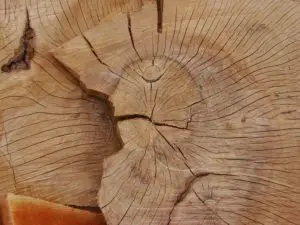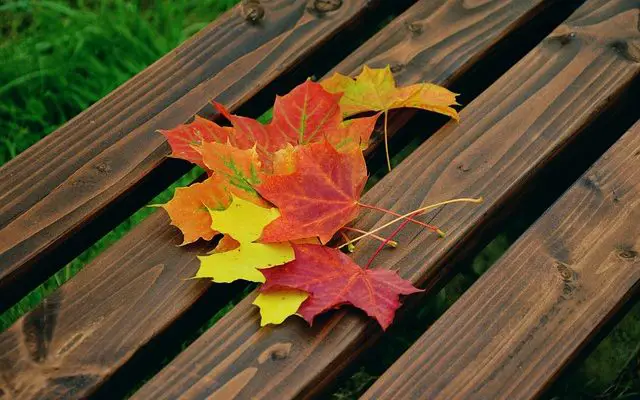Maple wood – just the thought of it evokes an autumnal warmth. From maple syrup to fall leaves, the maple tree is iconic in its versatility. But what about using maple wood for woodworking projects? This durable hardwood can be temperamental at best and disastrous at worst. But don’t let that deter you! Read on for tips and tricks regarding the use of maple wood for an array of woodworking projects.
About Maple Wood
Maple wood is well-known for its use in the production of durable furniture, as well as musical instruments, as it is a strong and attractive material once finished. It is a favorite among the hardwoods, but comes in multiple varieties. The most common of these is the soft or red maple. This maple is actually harder than many hardwoods, despite being the “softest” of its own variety.
 Sometimes, the grain of the soft maple is highly variegated, earning the name “tiger maple”, or in some instances these stripes take on a wavy, kinky appearance and are called “curly maple”. Clearly the grain of maple wood can be highly variable, but regardless of the grain, small knots or inclusions in the wood may be present- this is referred to as a “bird’s eye” pattern. With so much variation, there is an abundance of maple to choose from when designing a project.
Sometimes, the grain of the soft maple is highly variegated, earning the name “tiger maple”, or in some instances these stripes take on a wavy, kinky appearance and are called “curly maple”. Clearly the grain of maple wood can be highly variable, but regardless of the grain, small knots or inclusions in the wood may be present- this is referred to as a “bird’s eye” pattern. With so much variation, there is an abundance of maple to choose from when designing a project.
Regarding coloration, maple (especially soft maple) tends to have light brownish-grey to almost white sapwood surrounding the rich red-brown heartwood. Soft maples are also distinguishable from hard maples due to the light brown flecks that arise parallel to the grain, which are not generally found in hard maples.
Characteristics of Maple
The characteristics of maple wood vary depending on the type of maple being used. There are over 23 North American species of maple tree. Many fall into the soft maple category as outlined above, featuring light colored wood with pronounced grain in different patterns. Soft maple is not as tough as hard maple, but it resists the warping and twisting that may arise when using hard maple. Hard maple (also known as sugar maple) is the standby maple, known for its strength when bending, its wear-resistance, and its compatibility with shock and power tool use.
Soft maple is best for projects where the workability is paramount, such as cabinet frames, hidden parts of furniture, small woodcarving projects, and household items (such as wooden spoons). Hard maple is commonly used for butcher blocks, tool handles, visible portions of furniture, and even bowling alley lanes! Both categories of maple are extremely useful, but hard maple may require some extra effort as it is notoriously tricky.
Pros of Using Maple Wood
Mimic the look or expensive hardwoods for a fraction of the price! Maple is affordable and soft maple takes stains well, so instead of purchasing pricey cherry or walnut, simply stain maple to the desired color. Additionally, the harder varieties are durable and the perfect choice for heavy-use furniture and projects that need to last.
Maple has a workable texture and advantageous grain patterns that display and finish well. Projects made from maple wood tend to resist wear and decay, which makes maple a desirable wood for many uses. Finally, maple wood holds nails and screw well, and tends to resist splitting and warping, unlike some other hardwoods.
Cons of Using Maple Wood
Unfortunately, not all maple is created equal. The majority of maple wood is light colored and straight-grained, which can be good for some projects but if you are seeking the red hues and grain variations some maple can have, be prepared to pay a higher price. Additionally, the more durable and strong the maple, the more difficult to work

with. Hard sugar maple can quickly dull tool blades, and does not take glue or stain as well as softer varieties. If the wood is not treated and sealer properly, the staining can have imperfections and blotching once completed.
Maple wood can be susceptible to fungus and discoloration when left out to the elements, so this should be avoided. When used for flooring, maple tends to scratch easily if not treated with a protective coating. Maple woods, especially the harder varieties, also tend to warp and shrink as they are sensitive to environmental changes in the temperature and humidity.
Finishing- To Stain or Not to Stain?
When applied properly, stains and finishes can beautify maple wood and elevate the finished look of a project. Before any stain or finishing can be completed, the entire surface of the wood must first be sanded. This prepares the surface of the wood to take in the stain. Stains tend to highlight any imperfections in the wood, such as cracks and divots, so removing these is crucial to an even stain job.
After sanding but prior to staining, a pre-stain conditioner should be applied in order to further even out the wood’s surface and prevent post-staining blotches. An alternative to stain would be the use of oil to make the grain pattern stand out and create a polished surface. Linseed oil is commonly applied for this purpose. Since maple is commonly used for cutting boards, it’s important to ensure the finishing stain or oils you use are food safe. Take a look at this article I wrote for more details on what finishes are food safe for you kitchen.
After sanding, the oil should be applied evenly to the surface of the wood, and then coated in a clear-coat of shellac, finishing with clear lacquer if desired. This will even further reinforce and protect the already durable wood.
Tips and Tricks
Decided to try working with maple? Here are some general tips and tricks to make the process a bit smoother.
Decisions, Decisions
- Decide what your project is, and determine what variety of maple is needed. Only using maple wood for hidden parts of furniture, such as the base of an upholstered chair? Soft maple will suffice, and the grain/colorway is unimportant. Making a beautiful butcher block or hardtop desk? The grain, color, and variety of maple are much more important- be willing to shell out a few extra dollars if you are interested in tiger striping or curly striping grain.
Preparation
- Ensure that the wood is acclimatized and seasoned to prevent shrinkage or warping.
- Avoid allowing maple wood to sit out in the elements, as this can damage and weaken it’s structural integrity.
- Sharpen all tool blades, as this durable hardwood is known to take a toll on blades.
Working the wood
- Softer maple can burn up during cutting and machining; process and work the wood slowly and be cautious of the tendency for chipping.
- When using harder maple, lubricating screws and hardware can prevent damage to the wood or tools.
Finishing
- Avoid oversanding. When sanding, work with the grain using medium to coarse grit sandpaper to avoid burnishing the wood surface.
- Use wood conditioner prior to staining such as this one by Miniwax.
- Test the stain on a portion of the wood that is not readily visible, to determine if blotching is going to be an issue. Alternatively, use scrap wood to test stains and practice prior to staining the project.
- As an alternative to the difficulties of even staining on maple, consider dying using aniline dye.
You may hear that maple is difficult to work with, and this can be true. But now you are armed with the knowledge that will allow you to use maple in any project you see fit!




